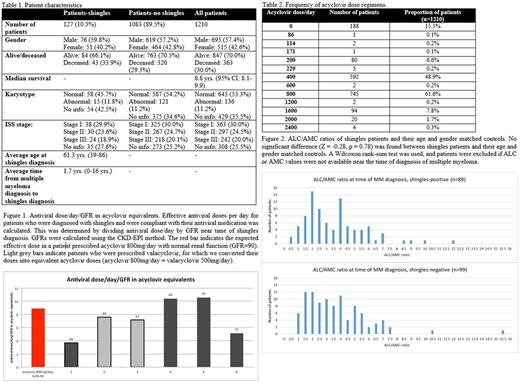Abstract
Background: CDC estimates that approximately 30% of persons in the U.S. will experience shingles during their lifetimes (http://www.cdc.gov/shingles/surveillance.html). The incidence among people 60 years of age and older is about 10 cases per 1,000 U.S. population annually. With a median age of 70 y.o. and frequent proteasome inhibitor use (Kim SJ et al, Clinical lymphoma & myeloma, 2008), multiple myeloma patients often receive scheduled prophylaxis for shingles with acyclovir or valacyclovir; however, there are currently no guidelines on the appropriate dosage for the prevention of shingles. Recent studies have used antiviral doses of acyclovir 2400mg/day to as low as acyclovir 200 mg/day to prevent shingles (Pour L et al., Clinical lymphoma & myeloma 2009; Kim SJ et al., Jpn J Clin Oncol 2011), but doses of 200-800 mg acyclovir per day are common in clinical practice. By reviewing all myeloma patients treated over the last 6 years, we hypothesized that a less than 1% failure rate can be achieved using the equivalent of acyclovir 400 mg twice daily in a patient with normal renal function. In addition, based on the findings of a recent study (Dosani T et al., Blood, 2017), which demonstrated that ALC/AMC ratio at time of multiple myeloma diagnosis can be used as an indicator of baseline immune status, we hypothesized in this present study that multiple myeloma patients who had shingles have a significantly lower ALC/AMC ratio on average than patients who did not have shingles.
Methods: A retrospective chart review was conducted on 1,210 multiple myeloma patients treated at The Ohio State University Wexner Medical Center. In addition to demographic information on age, gender, age at multiple myeloma diagnosis, multiple myeloma stage and karyotype, and length of survival, information on the presence of shingles after the diagnosis of multiple myeloma, medication and dosage of prophylactic antivirals, and compliance to medication was also collected. For patients who developed shingles and were compliant with prescribed antiviral medication, their effective dose of antiviral was determined by dividing their dose of antiviral per day by their estimated GFR at the time of shingles diagnosis. Valacyclovir was converted to an equivalent dose of acyclovir (acyclovir 400 mg = valacyclovir 250 mg). GFR was determined by the CKD-EPI method, using serum creatinine and weight values taken near the time of shingles diagnosis. ALC/AMC ratios were estimated using ALC and AMC values taken near the time of multiple myeloma diagnosis. Patients with shingles were compared to an equal number of age- and gender-matched controls using a Wilcoxon rank-sum test, and patients with no ALC or AMC values taken near time of diagnosis were excluded from final comparison.
Results: Demographic information on the patients included in this study can be found in Table 1. Out of 1210 multiple myeloma patients, 127 patients (10.5%) developed shingles after diagnosis, and of these, only 6 patients (0.5%) were both prescribed a prophylactic antiviral (acyclovir or valacyclovir) and were compliant with their antiviral medication (Figure 1). Most patients (77%) were not receiving antiviral prophylaxis, and even if antivirals were prescribed, only 21% were compliant. The average time from multiple myeloma diagnosis to shingles diagnosis was 1.7 years. For patients prescribed acyclovir prophylaxis, doses ranged 0-2400 mg/day, with most patients (62%) taking 800mg/day and 49% of patients taking 400mg/day (Table 2). Percentages do not add up to 100% since many patients had their doses changed over time. ALC/AMC ratios were not significantly different (p=0.78) between patients with shingles vs controls (Figure 2).
Discussion: Shingles occurred in 10% of myeloma patients during the retrospective period. Only twenty percent of myeloma patients that suffered a shingles exacerbation were prescribed an antiviral, and, if they were prescribed an antiviral, only 6 of 127 (4.7%) patients who developed shingles were taking prophylactic antivirals as prescribed. Given a compliance rate of 20.7% among patients diagnosed with shingles, compliance more than dose should be emphasized in preventing shingles exacerbations. This highlights the value of patient education and compliance strategies to decrease patient morbidity in clinical practice (Bender BG, JAMA Pediatr, 2015).
Hofmeister: Janssen: Research Funding; Thrassos: Honoraria, Membership on an entity's Board of Directors or advisory committees; Adaptive Biotechnologies: Honoraria, Membership on an entity's Board of Directors or advisory committees; Roche: Research Funding; Takeda: Research Funding; Karyopharm: Research Funding; Bristol-Myers Squibb: Research Funding; Celgene: Research Funding.
Author notes
Asterisk with author names denotes non-ASH members.


This feature is available to Subscribers Only
Sign In or Create an Account Close Modal